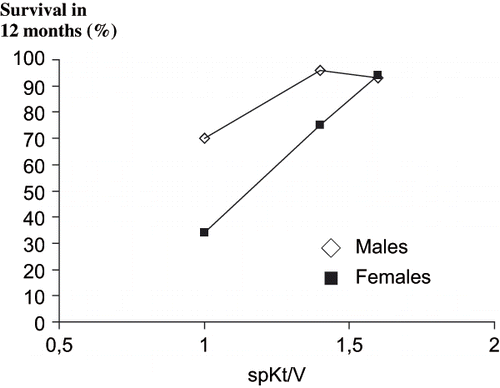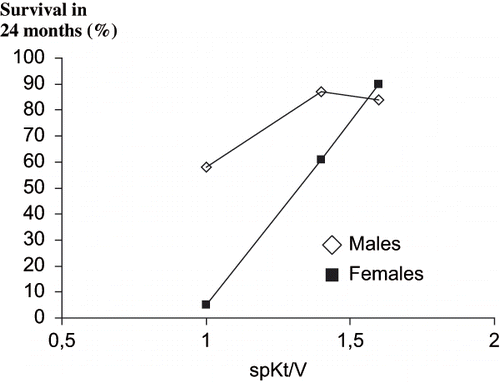Abstract
Many studies have demonstrated the relationship between dialysis dose and survival. Global mortality is similar among men and women; however, the influence of dialysis dose in the survival could be more intensive between women. Therefore, we conduct an observational study to evaluate the gender-related impact of single pool Kt/V (spKt/V) on the survival of patients submitted to hemodialysis in a university hospital. We found that survival was lower in groups with spKt/V smaller than 1.2 than in those with Kt/V between 1.2 and 1.4. Among female patients, spKt/V smaller than 1.2 had a more adverse effect in survival than among men with a comparable Kt/V. Otherwise, among women, the dialysis dose had an impact in survival even with Kt/V greater than 1.4. Thus, fractional urea clearance more heavily influenced the survival of females than males in hemodialysis patients.
INTRODUCTION
Among the factors related to dialytic treatment that are likely to be involved in the morbidity and mortality of chronic renal patients submitted to hemodialysis, dialysis dose is the most important.Citation[1] Dialysis dose can be quantified by means of single pool fractional urea clearance (spKt/V), which according to current recommendations, must be over 1.2, as well as by the urea reduction rate (URR), which should be over 65%.Citation[2]
Various studies have shown that inadequate dialysis dose is associated with a worse prognosis. Also, observational studiesCitation[3],Citation[4] have demonstrated the relationship between dialysis dose, survival, and factors such as gender, race, and body size, thus revealing that global mortality is similar among men and women and greater among patients with smaller body mass.
The HEMO study was the first controlled and randomized clinical investigation to evaluate the dialysis dose effect on mortality in relation to race, gender, and body size of patients submitted to hemodialysis. That study suggested that equilibrated fractional urea clearance (eKt/V) over 1.0 reduced morbi-mortality only among females.Citation[5] Thus, that study raised the possibility of a different impact of Kt/V among women and men.
Therefore, the purpose of this study was to evaluate the gender-related impact of spKt/V on the survival of patients submitted to hemodialysis in the University Hospital of the Botucatu Medical School.
METHODS
One hundred and forty-six consecutive patients undergoing substitutive renal therapy by hemodialysis were evaluated in the dialysis unit of the University Hospital of the Botucatu Medical School, UNESP, from 1998 to 2003. Of the total number of patients, 83 were males and 59 were females.
Blood and dialysate flows were adjusted according to medical orders, aiming at obtaining spKt/V ≥ 1.3. The patients were dialyzed by machines featuring ultrafiltration control (Baxter and Fresenius) using hollow fiber-dialyzers and polysulphone membranes. Manual reuse was performed, and sterilization was carried by peracetic acid.
The patients were divided into two groups according to gender, and each group was subdivided into three others based on the spKt/V range: smaller than or equal to 1.2, between 1.2 and 1.4, and greater than or equal to 1.4. Hence, the following groups were formed:
G1M: females with spKt/V smaller than 1.2);
G1H: males with spKt/V smaller than 1.2;
G2M: females with spKt/V between 1.2 and 1.4;
G2H: males with spKt/V between 1.2 and 1.4;
G3M: females with spKt/V greater than 1.4; and
G3H: males with spKt/V greater than 1.4.
The following variables were studied: age, creatinine, albumin, hematocrit, spKt/V, and presence of diabetes. The representative values for each variable were obtained by calculating the mean for the values of the three first hemodialysis months.
ANOVA was used for comparing the continuous variables between the groups, and life table and Cox regression were employed for survival analysis. A p value smaller than 0.05 was considered to be statistically significant. The data were expressed by mean ± standard deviation.
RESULTS
Creatinine, albumin, hematocrit, age, and presence of diabetes were similar in the different subgroups, except in G1M, where a higher percentage of diabetes mellitus was observed (see ).
Table 1 Clinical and laboratory characteristics of 146 patients undergoing hemodialysis according to gender and Kt/V
Among males, mean spKt/V was 1.22 ± 0.17 and Cox regression showed that spKt/V (p = 0.03) and albumin (p = 0.05) correlated with survival in a statistically significant fashion. Age presented a non-statistically significant tendency to influence survival (p = 0.07; see ). Among females, mean spKt/V was 1.42 ± 0.26, and in this group, Kt/V (p = 0.005), creatinine (p = 0.008), and albumin (p = 0.001) exhibited correlation with survival.
Table 2 Mean, standard deviation and Cox multiple regression significance levels (independent prognostic impact on survival) of the different clinical and laboratory characteristics
and show the percent survival in the different spKt/V subgroups for both genders. It is observed that, in general, in groups with spKt/V smaller than 1.2, survival was lower than in those with spKt/V between 1.2 and 1.4, regardless of gender. When comparing groups showing spKt/V greater than 1.4 with those presenting spKt/V between 1.2 and 1.4, survival was from 12 months forward 60 months greater in G3M. This impact was smaller among males with comparable Kt/V, as the distance of survival curves increased only at 48 and 60 months.
Table 3 Survival percent over time of 146 patients under hemodialysis according to gender and Kt/V
Figure 1. Survival over 12 months of 146 patients under hemodialysis according to spKt/V and gender.

Figure 2. Survival over 24 months of 146 patients under hemodialysis according to spKt/V and gender.

Figure 3. Survival over 60 months of 146 patients under hemodialysis according to spKt/V and gender.

When the survival curve was reconstructed by excluding diabetic women with Kt/V ≤ 1.2 in the female group (G1M), where there was a higher percentage of diabetes mellitus, results were the same (12-month survival of 17%, no patients alive after 24 months).
DISCUSSION
This study sought to evaluate the influence of gender on the impact of fractional urea clearance in hemodialysis mortality. Heavier impact of Kt/V on the mortality of females in relation to males at 12, 24, and 36 months was observed. After that period, males obtained an additional benefit from Kt/V greater than 1.2. Such impact was independent of the other co-factors studied.
Similar data were obtained in the HEMO study, an extensive randomized dialysis study in which the relative mortality risk was significantly lower in women receiving high dialysis doses (eKt/V of 1.45) when compared to women given a conventional dose (eKt/V of 1.0). In that study, the risk reduction found was of 19% between such two Kt/V ranges. An observational study also showed greater benefit from the high URR value in women, without a correspondence among men.Citation[6]
In the present investigation, as with findings in the other previously cited studies, the impact of dialysis dose on mortality was independent of the other variables. Poor survival in the G1M group could be explained by the higher frequency of diabetic women. However, when they were excluded, the new survival curve showed similar, if not worse, results.
Creatinine, albumin, and age showed some correlation with survival. Hematocrit, however, was not correlated with survival. Such observations are in agreement with data in the literature.Citation[7]
The reasons for greater survival in females, in relation to males, are not yet well understood. In men, there may be an adverse effect mechanism that cancels the beneficial effect of improvement in solute removal by high dialysis doses. Another explanation may be the generation of high doses of uremic toxins in women by mechanisms that are not fully clarified, which enables them to take advantage of greater potential benefit from high dialysis doses.
On the other hand, there is evidence that patients with a smaller body size may need greater spKt/V than larger patients. Hence, the impact of small dialysis doses could be greater among smaller-sized patients. Following this reasoning, the heavier impact of spKt/V on women could be explained by the smaller size, which is inherent to their gender.Citation[8]
CONCLUSION
Fractional urea clearance more heavily influenced the survival of females during hemodialysis. Additionally, higher mortality in females with low spKt/V was observed as compared to that in males.
ACKNOWLEDGMENTS
We would like to thank Mr. Fábio Paganini and Ms. Lidiane for technical assistance.
REFERENCES
- Eknoyan G, Beck GJ, Cheung AK, et al. Effect of dialysis dose and membrane flux in maintenance hemodialysis. N Engl J Med. 2002; 347: 2010–2019
- http://www.kidney.org/professionals/kdoqi/guidelines_updates/doqiuphd_ii.html, NKF K/DOQI Guidelines 2000. Guidelines for Hemodialysis Adequacy.
- Owen WF, Jr, Chertow GM, Lazarus JM, Lowrie EG. Dose of hemodialysis and survival: differences by race and sex. JAMA. 1998; 280(20)1764–1768
- Wolfe RA, Ashby VB, Daugirdas JT, Agodoa LY, Jones CA, Port FK. Body size, dose of hemodialysis and mortality. Am J Kidney Dis. 2000; 35(1)80–88
- Depner T, Daugirdas J, Greene T, et al. Dialysis dose and the effect of gender and body size on outcome in the HEMO study. Kidney Int. 2004; 65: 1386–1394
- Rayne HC, Pisoni RL, Bommer J, Canaud B, Hecking E, Locatelli F, et al. Mortality and hospitalization in hemodialysis patients in five European countries: Results from the Dialysis Outcomes and Practice Patterns Study (DOPPS). Nephrol Dial Transplant. 2004; 19: 108–120
- Lowrie EG, Lew NL. Death risk in hemodialysis patients: The predictive value of commonly measured variables and evaluation of death rate differences between facilities. Am J Kidney Dis. 1990; 15: 458–482
- Lowrie EG, Li Z, Ofsthun N, Lazarus M. Body size, dialysis dose and death risk relationships among hemodialysis patients. Kidney Int. 2002; 62: 1891–1897
